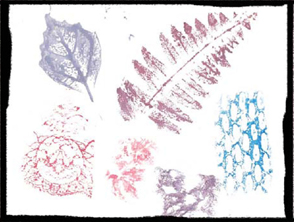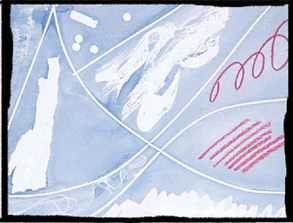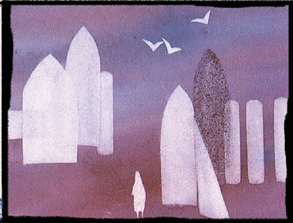Week 47
Test the Flexibility of Watercolor
BY NITA LELAND | from The New Creative Artist

Watercolors can enhance almost any piece of art-work, whether it's used in a full-wash background or just on a small element. This week, experiment with the nature of watercolors — use it with various resists, gouache and stencils. The results may surprise you!
Materials
 white gouache
white gouache
 casein
casein
 watercolors
watercolors
 paper
paper
 hair dryer
hair dryer
 various resists (liquid masking, rubber cement, stickers, masking tape, etc.)
various resists (liquid masking, rubber cement, stickers, masking tape, etc.)
 leaf
leaf
 various stencils
various stencils
 brayer
brayer
 various brushes, sponges, rollers, etc.
various brushes, sponges, rollers, etc.
Experiment With Watercolor


 Touch and spatter slightly diluted white gouache into a damp watercolor wash. The paint crawls and makes interesting feathery edges. Use a hair dryer to stop the action if you see something you like happening on the surface. When the paint is dry, work back into it to bring out an image or design.
Touch and spatter slightly diluted white gouache into a damp watercolor wash. The paint crawls and makes interesting feathery edges. Use a hair dryer to stop the action if you see something you like happening on the surface. When the paint is dry, work back into it to bring out an image or design.
 Test different kinds of resists with water-color washes. These resists can be applied to reserve white areas or to texturize. Apply liquid masking or acid-free rubber cement and let it dry, then apply watercolor washes. Rub off the masking or rubber cement, then add glazes or emphasize white areas with dark lines. For hard-edge designs, try masking tape and stickers. See my sample sheet below for more possibilities. Make a test sheet of your own.
Test different kinds of resists with water-color washes. These resists can be applied to reserve white areas or to texturize. Apply liquid masking or acid-free rubber cement and let it dry, then apply watercolor washes. Rub off the masking or rubber cement, then add glazes or emphasize white areas with dark lines. For hard-edge designs, try masking tape and stickers. See my sample sheet below for more possibilities. Make a test sheet of your own.
 Paint a leaf with gouache or casein mixed with watercolor. Place the leaf on paper, painted side down, and lay another sheet of paper on top. Roll a brayer over this sandwich to print the leaf. Make a sample sheet of printed textures like the one shown and incorporate some of them in a composition.
Paint a leaf with gouache or casein mixed with watercolor. Place the leaf on paper, painted side down, and lay another sheet of paper on top. Roll a brayer over this sandwich to print the leaf. Make a sample sheet of printed textures like the one shown and incorporate some of them in a composition.
 Use stencils to create unity and rhythm through the repetition of a shape. Vary the shape occasionally, changing its size and the spaces between the shapes. Cut stencils representing figures, flowers, leaves or geometric shapes from heavy paper. (I use old file folders.) Sponge out areas of a watercolor using a stencil pattern, or paint and spatter into the stencil design.
Use stencils to create unity and rhythm through the repetition of a shape. Vary the shape occasionally, changing its size and the spaces between the shapes. Cut stencils representing figures, flowers, leaves or geometric shapes from heavy paper. (I use old file folders.) Sponge out areas of a watercolor using a stencil pattern, or paint and spatter into the stencil design.

